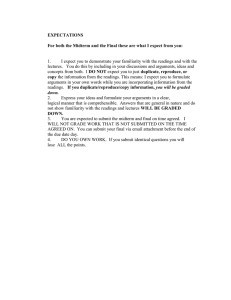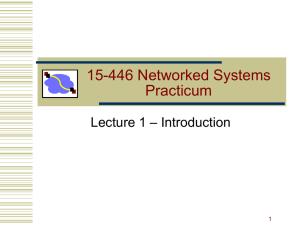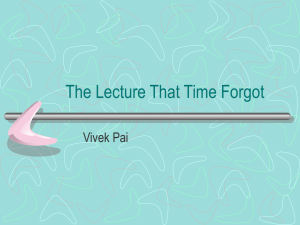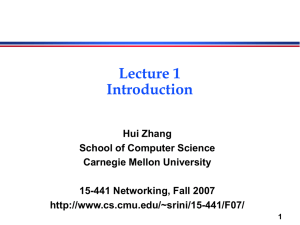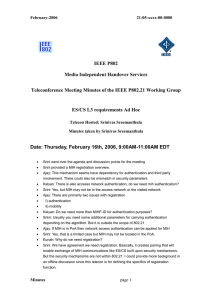L-1 Introduction 1
advertisement
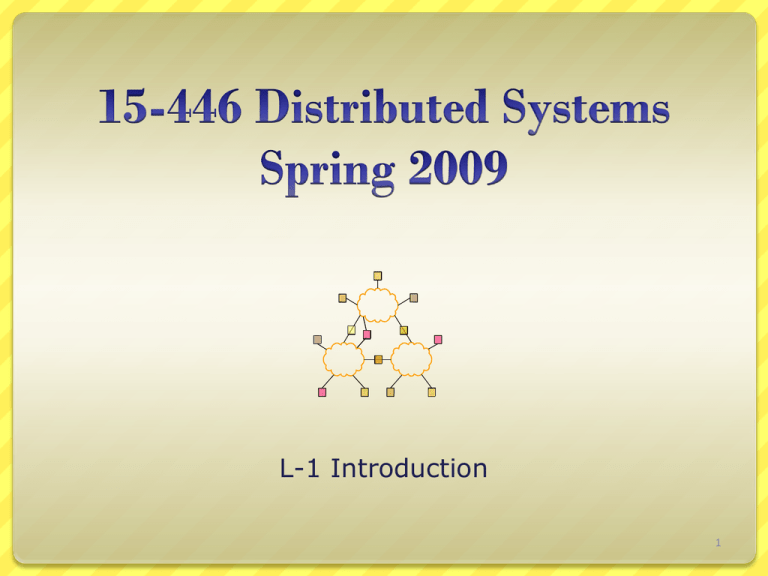
L-1 Introduction 1 Today's Lecture Administrivia Example topics 2 Instructors Instructor Srini Seshan srini@cmu.edu, Wean Hall 8113 Office hours: Thursday 1-2pm Teaching assistant Dongsu Han dongsuh@cs.cmu.edu, Wean 8218 Office hours: Mon 1:30-2:30 3 Course Goals Become familiar with the principles and practice of distributed systems algorithms, APIs, ... Learn how to write distributed applications that use the network How does a distributed file system work? Mobile/Ubiquitous computing focus Projects and programming done using Android platform 4 Android Dramatically updated class focus Distributed systems + mobile/ubiquitous New projects Project 1 Part A discovery protocol for mobile phones Part B distributed file updates with eventual consistency Project 2 Self-defined 3-person groups We’ll provide some ideas, but you can make up your own 5 Course Format ~30 lectures 4 paper/lab homework assignments 2.5 programming projects Midterm and final Cover the “principles and practice” Complete readings before lecture Loosely tied to lecture materials Teach networking concepts/tools How to use and build networks / networked applications Application-layer programming Larger, open-ended projects. Start early! Covers each of the above 3 parts of class 6 Lecture Schedule Syllabus online Lectures Tue/Thu 10:30-11:50 Recitations Wed 3:30-4:20 Used for: Project/programming related lectures Exam reviews Makeup lectures Not taught every week – keep an eye on syllabus 7 Reading Recommended textbooks Distributed Systems: Concepts and Design, 4rd ed by Coulouris, G, Dollimore, J., and Kindberg, T., AddisonWesley, 2006. ISBN: 0321263545 Distributed Systems: Principles and Paradigms, 2nd ed by Tanenbaum, A. and van Steen, M., Prentice Hall, 2007. ISBN: 0132392275 Either is fine, will post readings on Web page for both Both will be placed on reserve in library Paper readings Classic academic papers on different topics 8 Sounds Great! How Do I Get In? Currently 17 people are enrolled, and 13 people are on the waiting list. Limited to about 20 If you do not plan to take the course, please drop it ASAP so somebody else can take your place! Preference will not be based on online waitlist order We give preference to students attending class. Sign in sheet Preference given to undergraduates 9 Administrative Stuff Watch the course web page Read bboards Course secretary http://www.cs.cmu.edu/~srini/15-446/S09/ Handouts, readings, .. cyrus.academic.cs.15-441.announce for official announcements cyrus.academic.cs.15-441 for questions/answers Barbara Grandillo, Wean Hall 8018 10 Grading Roughly equal weight in projects and testing 20% 20% 15% 25% 20% for for for for for Project I Project II Midterm exam Final exam Homework You MUST demonstrate competence in both projects and tests to pass the course Fail either and you fail the class! 11 Policy on Collaboration Working together is important Final submission must be your own work Project 1 Project 2 Discuss course material in general terms Work together on program debugging, .. Homeworks, midterm, final Done independently Teams of three Collaboration, group project skills All students should understand the entire project 12 Late Work and Regrading Late work will receive a 15% penalty/day Requests for regrading must be submitted in writing to course secretary within 2 weeks. No assignment can be more than 2 days late Only exception is documented illness and family emergencies Regrading will be done by original grader No assignments with a “short fuse” Homeworks: ~1-2 weeks Projects: ~5 weeks Start on time! Every year some students discover that a 5 week project cannot be completed in a week 13 Today's Lecture Administrivia Examples topics 14 Topics Traditional Networking Naming Time synchronization Replication/Consistenc y Security Transactions Distributed file systems Group communication Cluster computing Ubicomp Wireless networks Localization P2P Sensor networks Adaptive applications Social networks P2P applications Android APIs 15 Definition of a Distributed System A distributed system is: A collection of independent computers that appears to its users as a single coherent system "A distributed system is one in which the failure of a computer you didn't even know existed can render your own computer unusable." – Leslie Lamport 16 Figure 1.1 A typical portion of the Internet intranet % ISP % % % backbone satellite link desktop computer: server: network link: 17 Middleware The middleware layer extends over multiple machines, and offers each application the same interface. 18 Transparency in a Distributed System 19 Pitfalls when Developing Distributed Systems False assumptions made by first time developer: The network is reliable. The network is secure. The network is homogeneous. The topology does not change. Latency is zero. Bandwidth is infinite. Transport cost is zero. There is one administrator. 20 Scalability Problems Characteristics of decentralized algorithms: No machine has complete information about the system state. Machines make decisions based only on local information. Failure of one machine does not ruin the algorithm. There is no implicit assumption that a global clock exists. 21 Reasons for Replication Data are replicated to increase the reliability of a system. • Replication for performance • Scaling in numbers Scaling in geographical area Caveat Gain in performance Cost of increased bandwidth for maintaining replication 22 Continuous Consistency 23 Transaction Processing Systems 24 Transaction Processing Systems ACID properties of transactions: Atomic: To the outside world, the transaction happens indivisibly. Consistent: The transaction does not violate system invariants. Isolated: Concurrent transactions do not interfere with each other. Durable: Once a transaction commits, the changes are permanent. 25 Failure Models 26 Next Lecture Networking intro Read “End-to-End Arguments” paper 27

